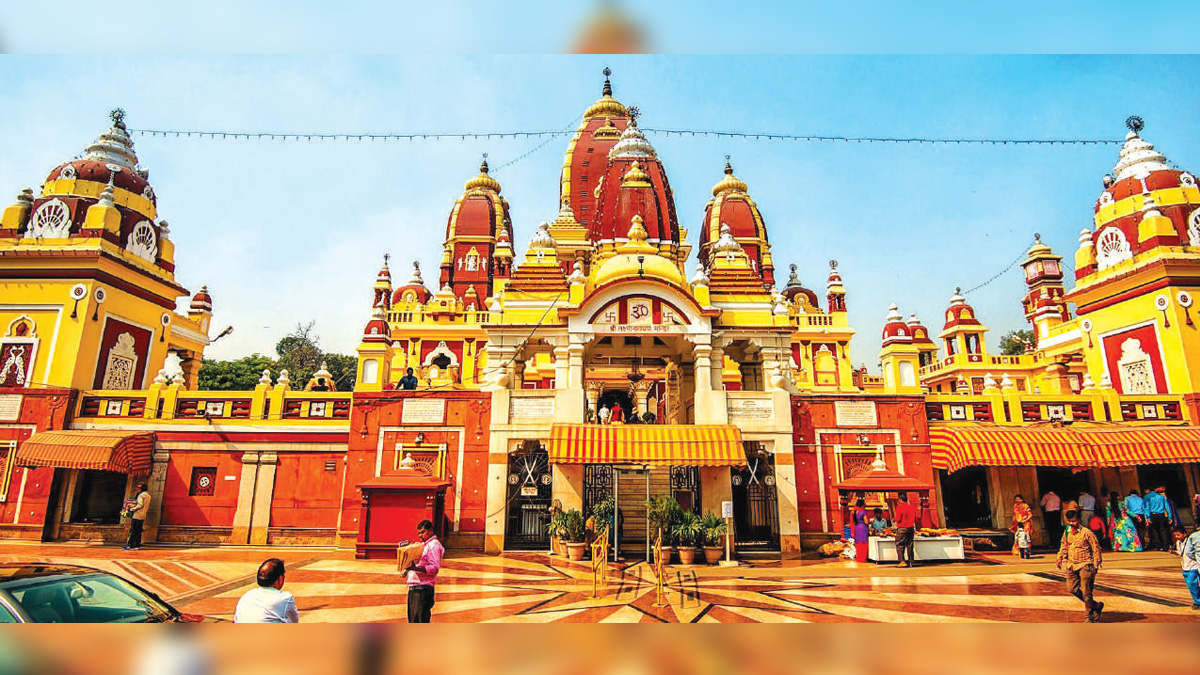“Why did you, a psychologist, wanted to meet me at this temple for this interview?”
“Have you been to this place before?” I asked. “Yes, have passed by it many times,” he said. “It is one of the biggest temples in size in Delhi. Quite beautiful and large.”
“Do you know the possible history behind it? For me it is just not a temple,” I said. “It is a place where I get reminded of the atrocities done on our people. It represents to me the aspiration of my people,” I told him. “It contains a memory for me which is like no other place.”
“I don’t understand,” he said.
I told him the story of my book.
“Yes, I have read the story but what is the connection?”
“It has the connection with every destroyed Hindu temple anywhere in the world. It is connected to every destroyed temple in Pakistan, Afghanistan and Bangladesh and India.”
“How many Hindus know your story or think like that way?” he asked me.
“Not many. But a day will come when many will.”
“And may I ask what makes you say so?”
“Hindus buried their memory deep inside. It is sleeping inside in some corner. But a day will soon come when it will emerge to remind us of what happened to us, our culture and civilization and our duty to dharma. I believe this temple should be seen as a memorial.” I told him.
As we both saw hundreds of devotees queuing outside for puja, he asked me, “How many of them do you think know of its history that you are talking about?”
“Perhaps none today. But one day many will come here also for what it stands for and symbolizes.”
“Why is there no board outside to tell us of its history about what you are saying? Why it isn’t inscribed anywhere? Why is it that no historian has talked about it?” he asked.
“Like most slaves and traumatized populations, Hindus remained ashamed of their history and did not want to be reminded of a humiliating past. Our historians hid it from us. But a time comes when a society begins to value its memory and knows there is nothing to be ashamed about one’s past and it is the perpetrator who should be ashamed and not the survivor.”
“When do you think it will happen?” he almost seemed to mock me.
“When we begin to look inwards and ask questions.”
I was giving an interview for the channel Al Jazeera and talking with Aatish Taseer. We stood outside Birla temple in New Delhi talking about rise of new India. They had offered me a choice of venues for the interview including any five star restaurants and then asked if I had a choice. They were keen to know my views as a psychologist on the rising India, the rise of nationalism and its causes. They had asked me to interview about my book ‘The Infidel Next Door’ and said it represented a new genre of writing in Indian fiction.
“So, how should one like to imagine the new narrative,” he had asked me.
“I would imagine a board outside the temple with the written history of the destruction of the temples in India and why it took Hindus so long to build large temples again after centuries. Every Hindu who comes here for puja should also know the story of his ancestors and how they found courage to undo that terror.”
“Would you say the same for destroyed temples all over India?”
“Yes,” I had answered. “I would like to see the Ram temple as not just another religious pilgrimage for the Hindu devotee, but also as a symbol for the world that tells of a memory not destroyed and which is inscribed at the gate of every temple so that our future generations know of the struggle needed to have kept the temples standing.”
“Won’t that fill the Hindus with hate and create violence?” he asked.
“Connecting to your roots doesn’t make you violent but gives rise to healing.”
“According to records there have been number of temples destroyed all over India. Is this physically viable?”
“There was one idea and that was to annihilate the Hindu civilization. When Blacks became aware of the Atlantic slave trade, they realized it involved millions over centuries. Every genocide has annihilated millions. When Native Americans became aware of their extermination by Whites they started to pray at the holy sites. Why it is only for Hindus that this question is asked?”
“No one in the ruling establishment will buy your idea of healing,” he had terminated the interview.
Subsequently only a small part of my interview was shown after editing.
How does a people, a nation connect to its lost roots? Thousands of sites that have been destroyed in India over centuries contain a sacred memory that lives on. When will we begin to see them as memory of a narrative?
For the uninitiated, Birla Mandir also known as Laxmi Narayan mandir was built in 1939 by the Birlas, a rich industrial family. What is puzzling to me is that Delhi, a city of Hindus has no history of large or big temple existing or built for almost a thousand years. It is a mystery as to why the Hindus, who had perfected the art of building temples never thought of building one for over one thousand years during Islamic and British rule? When one compares it with south India where huge temples dot the sky, it makes the record more puzzling and makes one wonder why such giant temples are missing in Delhi from medieval or ancient times when records exist of splendid temples from the past and the proof that Hindus were great architects.
The answer may lie in the fear in Hindus and the trauma that prevented the building of any temple for centuries that ended with the rising nationalistic fervor of the freedom struggle. Does that explain that while there are numerous medieval mosques dotting Delhi skyline that can be seen from afar and even churches, there is not a single medieval Hindu temple that is of similar size or comes anywhere near it? Does that also explain (it is my speculation) why a person like Gandhi came to inaugurate the Birla temple knowing its historicity that was kept hidden?
So, where and how does a society find its roots that they have been dispossessed from for centuries.
A Black professor Cornel West had once told me how important it has been for Black people to find, search for their dispossessed roots and connect and feel whole again. Even if centuries have passed, people want to go back in time, when their civilizations were razed to the ground, when they separated from their inner selves. He told me how it has helped millions of Blacks to visit ‘Point of No Return’ and discover their soul that was detached and come back feeling healed. Native Americans, he told me find it healing to stand at the spot of the massacre of ‘Bury me at the wounded knee’. Jews do that at Auschwitz and Buchenwald.
India is dotted with thousands of destroyed temples and places of desecrated memories such as Jouhar. They have a memory in that geographic entity that is alive through oral history and tradition of a remembered trauma of a language of silence. Isn’t it time we break that silence? I wonder if we shouldn’t start do so by a movement so that we reclaim these sites not only as religious pilgrimages but also places which tell the struggle and story of our saints?
Every year, millions of Hindus make pilgrimages to Somnath, Kashi Vishwanath, Krishna Janmasthan and monuments like Qutub Minar that are dotted across the country being mute spectators of attempts to create a genocide of our civilization. It is high time we add another definition of pilgrimage to ourselves, one that should remind us of the blood spilled in the name of our religion, the beheadings, the Jouhars, being sold as slaves and for all those who stood against conversion, annihilation and did not give up till their last breath. If that story doesn’t get remembered today by us, we may leave a void for the future generations that may continue to echo for a long time asking for justice.
About the Author
Rajat Mitra is a Psychologist, Speaker and Author of ‘The Infidel Next Door’



![[ India Today ] Ohio senator JD Vance thanks wife, a Hindu, for helping him find Christian faith](https://hinduvishwa.org/wp-content/uploads/2024/06/us-senator-jd-vance-reveals-how-his-hindu-wife-usha-helped-him-find-his-christian-faith-image-re-272530504-16x9_0-120x86.webp)










